WeatherFest is always a highlight of the opening weekend of the Annual Meeting, and this year was no exception, as exhibitors inspired and amazed children (and adults!) of all ages with their weather-related presentations. As these photos depict, the wow factor was high!

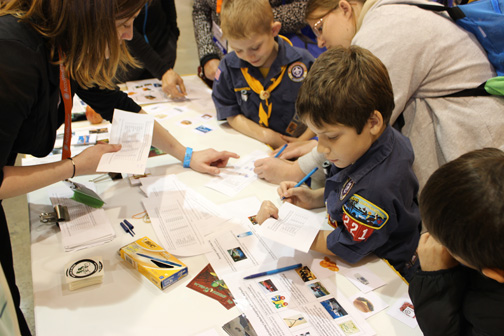
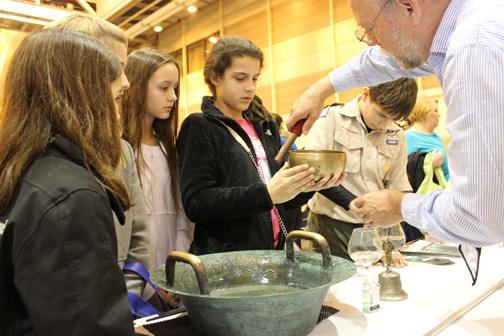
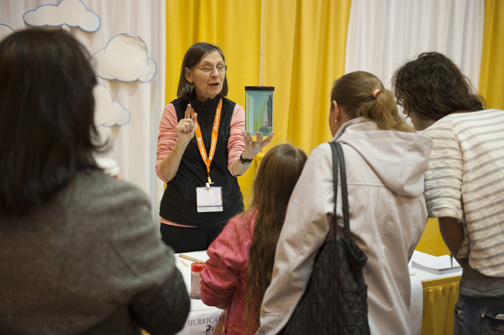
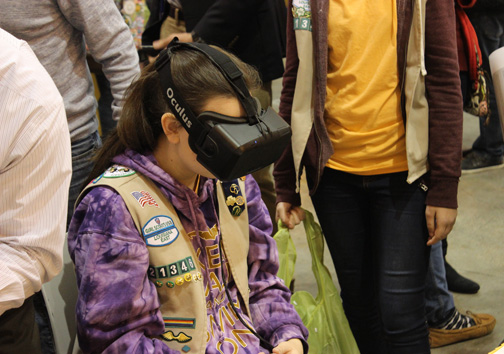

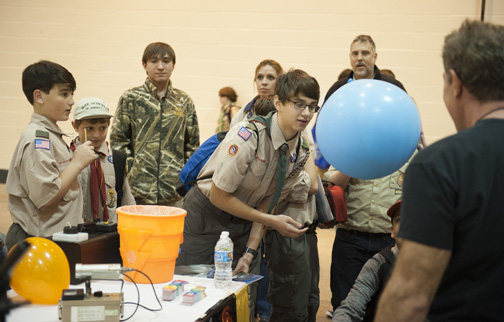
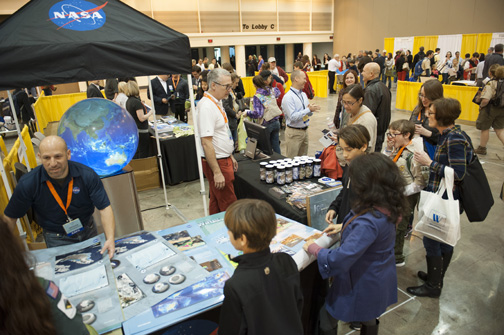
The AMS Annual Meeting: Much More than Science
The Annual Meeting is upon us! This year, we return to the beautiful city of New Orleans expecting yet another great meeting full of stimulating ideas, valuable information, and new products.
The Annual Meeting is well known for bringing together more than 3,000 scientists, researchers, professionals, educators, students, and others across the weather, water, and climate community. The more than 2,000 presentations and 900 posters cover an incredible array of topics and disciplines that represent the cutting edge of scientific thinking, technology, research, collaboration, and understanding. 
Yet you probably realize the success of the meeting goes beyond merely showcasing vital science and services. The Annual Meeting is also a great opportunity to engage in networking and career development for early-career, midcareer, and even late-career professionals. We hear every year from attendees who tell us how much networking means to them, and how much they appreciate a chance to meet with peers and colleagues, some of whom they see only this one time a year.
The weather enterprise has grown and changed immensely over the past decade, and many expect that to continue in the years to come. Today, we see areas of science coming together more intensively than ever to share, work, and collaborate. People in fields like energy, agriculture, transportation, and the social sciences work closely with physical scientists. These are important developments for those who are interested in starting–or changing–their careers.
This year’s meeting offers attendees many opportunities to listen to talks and presentations on careers in the public, private, and academic sectors across the enterprise.
Sunday’s Conference for Early Career Professionals will feature numerous helpful discussions—from advice on networking and interviewing to help with finding a mentor and mastering “soft skills.” The conference will also include a panel discussion of professionals who will share their perspectives on atmospheric sciences careers.
The AMS Board for Early Career Professionals will also host a Town Hall Meeting on Monday on “ ‘Outside the Box’ Skillsets for Staying Relevant and Landing the Next Job,” which will highlight skills that may not be required in an academic curriculum, but could be valuable in a resume.
Wednesday’s Town Hall Meeting on “Demystifying Careers in the Atmospheric Sciences” will present an overview of employment in the weather, water, and climate sciences. What skill sets are most important to employers? What employment trends and changes are occurring, and what are some areas of future growth? This meeting will explore those and other career-related questions.
For budding broadcasters, Tuesday’s Town Hall Meeting on “The Work Behind the Scenes” will provide a glimpse at some of the research broadcast meteorologists work on when they’re not in front of the camera—showing that there’s more to the job than may meet the eye.
And for students, this Saturday’s Career Fair will allow attendees of the AMS Student Conference to view available job opportunities, network with government-agency and private-industry employees, meet graduate school recruiters, and schedule interviews with school representatives and potential employers.
This is just a sampling of the career-related events taking place during the week. The Annual Meeting is a great chance to better connect to your career goals and directions. It’s also a great opportunity to meet others while networking with peers and colleagues engaged in the work of benefitting society with the science of weather, water, and climate.
Flowing with the AMS Annual Meeting Theme
The 96th AMS Annual Meeting is just around the corner, and there are many reasons to be excited about spending a week devoted to making connections across the weather, water, and climate enterprise. The meeting promises to be an intensive focus on the incredible work you’re doing, but before we get there, now’s is a good moment to take a closer look at this year’s theme, Earth System Science in Service to Society.
AMS President Alexander E. “Sandy” MacDonald’s provides an inspiring explanation of how he came up with that theme to “bring the many parts of AMS” together. Here’s what he says about the first three words, “Earth System Science:”
The “Earth System Science” theme emphasizes that the growing knowledge of the academic and research communities about our Earth system is a strength of AMS. AMS brings together the physical, chemical, and biological study of the Earth, allowing important decisions to be made by policy makers and the public. An example of the physical domain was the forecast of Hurricane Sandy, which was predominantly atmospheric and ocean model driven. An air quality forecast would exemplify the chemical and physical domains. The fate of global carbon illustrates the overarching importance that includes physics, chemistry, and biology. All of Earth’s biology participates in the carbon cycle, in which the chemistry of the ocean and atmosphere is of crucial importance, and which are controlled by the physical ocean and atmosphere. The Earth system also includes the human-centered “domains of action”: (1) Observing, (2) Analysis and research leading to understanding, (3) Modeling and prediction, and (4) Social sciences – how people deal with Earth. The AMS integrates these different disciplines in a common intellectual and operational framework with an Earth system emphasis – I believe that the AMS is the scientific society where the whole Earth System fits most comfortably.
The theme indeed captures the wide spectrum of sciences in the weather, water, and climate enterprise. The AMS Annual Meeting serves a growing need to share the incredible work you do, across many fields of science, in order for the whole community to advance its understanding of how the entire earth system works, functions, and evolves.
Yet rarely do we take time to see that broader picture. Search “Earth System Science” in our journals database, and you’ll find hundreds, if not thousands of references to job and academic department titles, but a scant handful of actual article titles or abstracts overtly address that encompassing mandate. Instead, science papers generally are a tightly focused within specific disciplines. We all know that a single discrepancy between a dataset and a theory can consume an entire career, let alone a solitary paper.
That’s one reason the AMS Annual Meeting is so special. Normally, we are engrossed in furthering our specific tasks, even at conferences. This meeting, however, is also a rare period of time set aside to look around us and explore our broader scientific context—to get into the flow of our times. Watch for that word “flow” as Sandy explains the rest of the theme, “In Service to Society”:
The second half of the theme title connects research to the benefits that society writ large gains from our science. “Service to Society” includes information services, such as operational weather prediction, provision of timely and accurate weather literally at our fingertips, and scientific assessments such as the Intergovernmental Panel on Climate Change that help guide society’s actions. It also includes the growing climate services from programs like NIDIS and the efforts to help society mitigate and adapt to climate variability and change. “Service to Society” explicitly evokes the integrated and complementary government and commercial enterprise that the AMS has done so much to foster over the last decade. The strong AMS contingent of media professionals – the people who stand before TV cameras and explain what the coming storm will do – are surely at the forefront of serving society, as are the critical efforts of the National Weather Service and military weather services. “Service to Society” also effectively uses social science to make the benefits and dissemination of our information most beneficial to the public. This meeting will address the effort to improve communications of geophysical threats to the public.
Finally – this theme conveys the flow inherent in the nearly 100-year history of the AMS. Some people call it research to operations (R2O), but I like to call it “Science to Service.” AMS has a proud history of making a positive difference in the lives of our citizens by continually making the advances of science available to the public and policy makers. The 2016 meeting will bring these two great endeavors together.
Over the years, there have been many meaningful solutions to writing the Annual Meeting theme. The thing that really raises “Earth System Science in the Service of Society” above the routine is that “flow inherent in the nearly 100-year history of the AMS.” We are indeed a scientific society immersed in the research-to-applications flow. AMS keeps that river of ideas and technologies moving, at every stage. Embracing “Earth System Science in Service to Society” in New Orleans is a part of the primary directive of the AMS to “advancing the atmospheric and related sciences, applications, technologies, and services for the benefit of society.”
There is yet another flow embedded in the eddies of Annual Meeting week that is only implied in Sandy’s theme. When we emerge at the far end of Thursday, the theme itself will be transformed in our eyes. It will be rewritten by our observations and experiences in the conferences, conversations, and special events. Every year at the Annual Meeting, without fail, all of us travel further downstream in science and in service.
2016 Washington Forum to Focus on Risk Management
by Shawn Miller, Chair, Board of Enterprise Economic Development
The AMS Board on Enterprise Economic Development invites you to attend the 2016 AMS Washington Forum, April 12-14, 2016, at the American Assocation for Advancement of Science (AAAS) Building in Washington, D.C. The purpose of the AMS Washington Forum is to provide an opportunity for members of the weather, water, and climate community to meet with senior federal agency officials, Congressional staff, and other community members to hear about the status of current programs, learn about new initiatives, discuss issues of interest to our community, identify business opportunities, and speak out about data and other needs.
This year’s theme is “Leveraging Environmental Intelligence to Enhance Risk Management.” Following that theme, the Forum will focus on the use of weather, water, and climate data–together creating a foundation for environmental intelligence–to support risk management across the public and private sectors. This includes agencies and companies whose operations and planning are dependent on environmental factors, as well as agencies and companies whose primary mission is to identify, analyze, and/or mitigate environmentally induced risks. Several special topics are planned for interactive panel discussions, each with a special focus on risk management, including an overarching theme session, environmental security, water resources, space weather, big data, and renewable energy.
We will invite senior leaders from agencies such as NOAA, NASA, DoD, and FEMA to look ahead and provide updates on current weather, water, and climate programs and provide insights on new science initiatives and directions. We will also invite leaders from the Office of Management & Budget and the Office of Science & Technology Policy, and from Congress, who will discuss the latest programs and legislative initiatives in our enterprise to better serve the American people. For our keynote, we have invited Dr. DJ Patil, U.S. Chief Data Scientist at the White House Office of Science and Technology Policy.
We hope to see you in D.C. in April!
Letting Scientists Benefit Us All
Lately you may have noticed that AMS has garnered media attention by standing up for NOAA scientists who are the focus of Congressional scrutiny. This scrutiny was initiated after the scientists re-analyzed global surface temperatures with newly corrected data and found that the warming trend of the second half of the 20th century has been continuing unabated since 1998 instead of experiencing what sometimes has been portrayed as a warming “hiatus.”
AMS doesn’t step casually into political arenas. As a non-profit scientific and professional society, we remain solidly grounded in the world of science. We help expand knowledge and understanding through research and, as our mission states, we work to ensure that scientific advances benefit society. We engage the policy process to help inform decision making and to help ensure that policy choices take full advantage of scientific understanding.
This case is slightly different, however, because the scientific process itself is at risk. When the scientific process is disregarded or, worse yet, possibly derailed, a political issue can become an AMS issue.
The scientific process that AMS and other like-minded institutions have championed over the centuries is about taking careful observations, conducting controlled experiments, separating personal opinions and beliefs from evidence, and, perhaps most critically, exposing scientific conclusions to rigorous and repeated testing over time by independent experts. These repeated cycles of distribution and “trial by fire” happen most notably at meetings, in peer-review, and in publication.
Crucially, the process systematically removes as much as possible of our human tendency to see what we want to see and puts the burden of proof on reproducible steps. It is a disciplined, particular way of finding truths, no matter how elusive, while rendering biases, opinions, and motivations as irrelevant as possible.
This systematic approach to separating fact from opinion occasionally goes astray, of course, but its iterative nature means that science is continually self-correcting and improving; better data and understanding ultimately replace older thinking. Science encourages people to question and challenge thinking, certainty, and accuracy—but it requires they focus exclusively on what they can detect and measure and reason.
Even though all the data, logic, and methodologies are publicly available, the paper rejecting the global warming hiatus inspired Congressional requests for additional email and discussions. Asking for these correspondences—especially from scientists themselves—can easily weigh down the ingenious process by which science has continually advanced. And so AMS made public statements in favor of letting science freely work its wonders. It’s not the first time AMS has done so, and it probably won’t be the last.
We owe much of modern prosperity to an unencumbered scientific process, and it continues to provide some of the most profound and dramatic advancements in the world. This includes medicine, biology, chemistry, computing, agriculture, engineering, physics, astronomy, and, of course, meteorology, hydrology, oceanography, and climatology. Every one of us benefits every single day from what scientists have learned, shared, and provided.
And that’s yet another reason why occasionally AMS must speak out—because of our mission “for the benefit of society.” The point is not just to protect science but also to protect the benefits that knowledge can provide to all of us, no matter what we think of the results. In this, our scientific society actually has much in common with the politicians and policy makers in Washington, D.C.
AMS stands behind the scientific process and will defend that process when necessary, but our goal is to work with policy makers to promote having the best knowledge and understanding used in making policy choices.
Naming Winter Storms: Time for Community Cooperation
by Mary M. Glackin, Senior Vice President, Public-Private Partnerships, The Weather Company
Forecasts of hazardous weather have continually improved, particularly over the past few decades. It is oft-cited fact that 5-day forecasts are now as good as 3-day forecasts were 20 years ago. At the same time, the public has more choices than ever in how it accesses weather information. In particular, we are seeing explosive growth in the web, apps, and social media outlets such as Facebook and Twitter. Yet in the aftermath of a severe event, it is common to hear, “I didn’t know” either from public officials or the public at large.
It is this latter issue that the United Kingdom’s Met Office and the Irish Meteorological Service (Met Éireann) were seeking to address when they recently announced their plans to name storms this fall and winter. And to kick the campaign off, they are soliciting the public’s help in picking the names. After watching other country’s experiences, they believe naming significant storms will increase public awareness of severe weather and thus improve appropriate responses to warnings.
Several European countries name winter storms. For example, the Free University of Berlin’s meteorological institute has been naming them since the 1950s, and these names are adopted and used by the media and the German Met Service, Deutscher Wetterdienst. In the U.S. and elsewhere, very impactful storms become named by the media; think Snowmageddon in the Northeast (2010) and St. Jude Storm in the U.K. (2013). In the U.S., The Weather Company (TWC) began naming winter storms in 2012-13, citing the importance of communicating in social media–especially Twitter, which requires a hashtag. Rightly or wrongly, this effort was roundly criticized as having suspect science and for being a marketing ploy.
After three years experience at TWC, here is what we can report: Twitter alone provides an incredible reach where we routinely see more than one billion people receiving tweets using the storm name. Millions of tweets are sent using the hashtag from government agencies, school districts, utilities, businesses, and the general public. These hashtags also allow the NWS and others to find real-time weather data tweeted by citizens that can be used in nowcasts and other storm reports.
The criteria to name a storm are pretty simple: it must meet the National Weather Service winter-storm warning criteria, and it must be expected to impact at least two million people and/or 400,000 sq. km. We use a formal process and a committee of three meteorologists to review these criteria for each possible storm, and while we consider the criteria strict, the storm-naming committee still reserves the right to override the quantitative decision in certain circumstances. Some of the factors that may influence decisions to override the naming rules include the degree of historical significance of the event (e.g., accumulating snow in South Florida, a summer-season snowstorm, etc.); see more details here. The U.K. is planning a similar system using their two highest warning levels, so names are only applied to the storms that present a significant threat.
What’s in a name? Well in this case, the name is the headline to attract attention to the threat. It is the beginning. It needs to be backed up with easy-to-understand information that details the threat to a specific locale and appropriate call-to-action statements. But, in this information-saturated world, this headline/hashtag is key. We need to recognize the importance of serving people in the way they find easiest to consume information vs. how we are most comfortable in delivering it.
Could we take this U.K./Ireland announcement as a call to the U.S. weather enterprise to come together to see how we could maximize the use of social media to improve the public response to severe weather events? Twitter is here to stay, and it requires hashtags to separate the relevant information from an avalanche of incoming data. Hashtags are spilling over into other social media as well. It is easy to create a hashtag from a tropical storm name. If we could come together as a community to address this for winter storms, we’d no doubt learn a lot that could then be applied to significant weather at the local scale. The nomenclature could be something much different than what’s used in tropical storms or what we have been using.
What’s important is to lead as a community in this social media era. For our part, we are willing to share our experiences, transition our system, and/or help set up an enterprise-wide naming system. During major snow events, the reach on Twitter has been over a billion. What would our reach be with all of us working together feeding into the same system to keep people informed during these hazardous events? Are we ready to re-engage on this topic as a community?
Summer Meeting Leads to Summer Tweeting
A primary focus of this week’s AMS Summer Community meeting in Raleigh, NC, has been communication, particularly about how best to present information on weather, water, and climate threats to the public. So it’s not surprising that the meeting has generated plenty of activity on Twitter. Here are a few of the highlights:
10 yrs ago social science was mentioned once. Now it's mentioned in the first 5 mins of @NWS director's remarks. #progress #AMSsummer #wasis
— Gina Eosco (@WxComm) August 3, 2015
Happening now…Dr. Lackmann keynote stressing collaboration #AMSsummer pic.twitter.com/d9AMVd5g8P
— Douglas Hilderbrand (@dcweatherbrand) August 4, 2015
I love when my feed fills up with yummy weather information, models, data, and talks #AMSsummer
— Erin (@ErinKSWX) August 4, 2015
Great innovative idea to use Maya (animation/film studio software) for visualization of weather model forecasts. #AMSsummer
— Minh Phan (@WXMinh) August 4, 2015
Lackmann; "explore possibilities for collaboration with gaming/movie industry/googlemaps/virtual reality to convey forecasts" #AMSSummer
— Kevin Kloesel (@texasembassy) August 4, 2015
YSG: For impact-based decision-support, have to understand how people react to risk – Dr. Uccellini #AMSSummer
— AMS Policy Program (@AMSPolicy) August 4, 2015
This quote from 1993 rings true still #AMSSummer, @NWS using NYC blizzard "miss" to highlight reality vs perception pic.twitter.com/PdXvw5LYqi
— Marshall Shepherd (@DrShepherd2013) August 4, 2015
@NWSDirector emphasizing that wx forecasts have no intrinsic value. They only become valuable if used to make good decisions. #AMSsummer
— Kevin Kloesel (@texasembassy) August 4, 2015
agreed! The best functioning of the NWS requires local offices deeply interconnected with local communities. #AMSSummer
— Susan (@CommDocPA) August 4, 2015
Big improvements coming to @NWS models, @NWSDirector just showed timeline, think Euro vs GFS disc will become yesterday's news #AMSsummer
— Marshall Shepherd (@DrShepherd2013) August 4, 2015
If I asked average person on street to describe what I mean by probabilistic forecast, I wonder what "range" of answers would be #AMSSummer
— Marshall Shepherd (@DrShepherd2013) August 4, 2015
The weather community has SO much data. What would happen if we gave it to #dataviz folks to rethink what weather "looks" like? #AMSsummer
— Gina Eosco (@WxComm) August 4, 2015
great discussion by J. Porter of @accuweather on challenges related to forecasting hazards, grid baed products, probability #AMSsummer
— Marshall Shepherd (@DrShepherd2013) August 4, 2015
@TWCBryan making great #AMSSummer point: Decisions are deterministic. Therefore probabilistic info still has to be interpreted in that way.
— Kevin Kloesel (@texasembassy) August 4, 2015
@kimklockow just illustrated that nobody in this room models the behavior that we seek from our constituents #AMSSummer #practicethepreach
— Kevin Kloesel (@texasembassy) August 4, 2015
AMS Summer Community, specialized meeting compared to larger @ametsoc but encourage u to put on future met bucket list #AMSSummer good stuff
— Marshall Shepherd (@DrShepherd2013) August 4, 2015
If we want to maximize public response, then we study weather from the bottom up rather than pushing change on the public #AMSsummer
— Gina Eosco (@WxComm) August 4, 2015
"How to maximize public response to longer warning lead times?" – Reverse the Q. Does the public need longer lead times? #AMSsummer
— Gina Eosco (@WxComm) August 4, 2015
When developing new policies for wx products, need to think about the media channels of the future #AMSSummer
— John Ten Hoeve (@John10Hoeve) August 4, 2015
#AMSSummer Community Meeting just presented a warning exercise. One of the best presentations at any mass conference in my career.
— Brad Huffines (@lukeskywatcher) August 4, 2015
Berchoff: Forecasters have probability biases .. can we train this out? Do we all agree what probability of precipitation means? #AMSsummer
— Gina Eosco (@WxComm) August 4, 2015
95% of new satellite data will be wasted on the floor. -Don Berchoff, discussing other resources that need time and priority. #AMSsummer
— Brad Huffines (@lukeskywatcher) August 4, 2015
More data should require that we have and use data analysis tools to utilize ALL the data. #AMSSummer
— Susan (@CommDocPA) August 4, 2015
What is the future of forecasters and their graphics? Will we see more consistency between graphics in different WFOs? #AMSsummer
— Castle Williams (@WxCastle) August 4, 2015
What will the future US energy system look like? Look to Germany because they are really pursuing renewable energy. #AMSsummer
— Minh Phan (@WXMinh) August 5, 2015
Takeaway from this AM's #AMSsummer panel: There is $$$$$ to be saved and made by improving weather forecasts for renewables, AQ, and more.
— Nate Johnson (@nsj) August 5, 2015
Birkland: Katrina 10 years later – Did we learn anything? We have to assess if we're doing anything differently. #AMSsummer
— Gina Eosco (@WxComm) August 5, 2015
Birkland: There's a difference btwn a "lesson learned" & a "lesson observed". Most often what's called the former is the latter. #AMSsummer
— Nate Johnson (@nsj) August 5, 2015
Birkland: What is the weather community? Forecasters, communicators, and enthusiasts… bloggers, public science, home wx stns. #AMSsummer
— Nate Johnson (@nsj) August 5, 2015
Birkland: Weather community at all levels play a big role. Forecast communication is useful to empower action. #AMSsummer
— Gina Eosco (@WxComm) August 5, 2015
Birkland taking a stab at all the TV branding – "first warning weather" "you're doomed weather". Is this helpful? #AMSsummer
— Nate Johnson (@nsj) August 5, 2015
Birkland: Most ppl get risk/hazard info from multiple sources. #AMSsummer – Yup! They combine lots of info. The days of one source are gone.
— Gina Eosco (@WxComm) August 5, 2015
This is what the future of local multimedia (not just broadcast) meteorology is about. Thanks @ericagrow #AMSsummer pic.twitter.com/xXgdeZBK1O
— John Morales (@JohnMoralesNBC6) August 5, 2015
Comment from audience: We mets need to do better job expressing uncertainty when it exists so we don't sound like we're waffling. #AMSsummer
— Nate Johnson (@nsj) August 5, 2015
#amssummer This meeting rocks! Wish I attended event in past years. Great cross-dislipinary, knowledge sharing.
— H. Michael Mogil (@hmmogil) August 5, 2015
A New Web Vision
by Tom Champoux, AMS Communications Director
You may have noticed that AMS rolled out a new website today, updating content and navigation in a brand new design. We hope you like it. This is a critically important step for AMS as we continue to improve the communication of our value to our members, to the greater weather, water, and climate community, and to society.
Many tens of thousands of people in our community work extremely hard to create and share knowledge to benefit society. Our website is a tremendously important vehicle in supporting that effort—engaging, informing, and inspiring people. It is a place for the entire community to connect, share, and collaborate. The redesign helps the website do all this by capitalizing on more up-to-date technology and creating a more modern online experience. 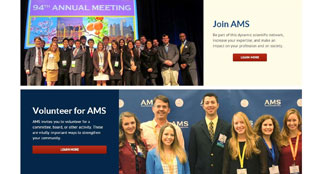
The new look points the website in a new direction, as well. Immediately you’ll notice the shift in the homepage, which previously tried hard to be all things for all people, inevitably with limited success. The new home page focuses less on engaging members directly. Instead, we put more focus on educating all visitors about how AMS supports and strengthens this vibrant community. As a result, navigation is simpler and cleaner; there are more images to convey the excitement, dedication, and enthusiasm that is so apparent across the entire enterprise.
Throughout, the colors are more modern, and the look and feel better represent the tremendous passion and commitment of AMS members and their community. We wanted to accurately capture that spirit in this new site, and of course make it is easy to find what’s new at AMS.
We felt the website would serve AMS best by
- delivering the AMS’s core assets;
- educating and inspiring audiences inside and outside the community;
- expressing the value of AMS to society at large; and
- creating community, bringing audiences together.
Those audiences extend far beyond our membership. While AMS has more than 13,000 active members, we reach a much larger and vibrant community that includes more than 28,000 Facebook and 10,000 Twitter followers. There are also thousands more volunteers, meeting attendees, presenters, authors, and many others who are deeply engaged with AMS and our work, but are not currently active members. These audiences span the career spectrum, from students to late-career professionals. We reach thousands of educators as well as all kinds of enthusiasts. We believe AMS has much to offer everyone and we wanted to be sure the website effectively showed all the ways we can help the community and society.
We’ll continue adding new content, updates, and information in the coming weeks and months to ensure that the AMS website remains a dynamic, engaging online experience for all audiences. We welcome your feedback and comments.
Is This Our Moonshot Moment?
by Douglas Hilderbrand, Co-Chair, AMS Board on Enterprise Communication
Have you ever imagined being a NASA scientist back in the 1960s – staring at the seemingly impossible challenge to send people to the moon and return them back to earth safely? And, doing it with the entire world watching? For the weather, water, and climate “enterprise,” that grand challenge might well be upon us.
Extreme events are now a fixture on the evening news, captured by miniature cameras and video recorders in our hands, and shared across our network via social media. Yet, heartbreaking stories of lives lost and communities devastated continue. Is this our moonshot moment? Physical science, social science, and technological advances have aligned to where the foundational warning process can take a giant leap forward from the time of lunar landings in the early 1970s to today’s smart phones.
On 4-6 August, leaders across government, academia, and industry sectors will come together at the AMS Summer Community Meeting on the campus of North Carolina State University to engage one another on how to modernize the end-to-end warning process. This summer’s theme, “For the Greater Good: Strengthening Collaboration, Consistency, and Trust to Support Informed Decision Making,” points to the ingredients that are needed to take a giant leap toward:
- Improving how weather, water and climate threats are predicted and communicated
- Enhancing information for risk management decisions through better expression of urgency and confidence
- Supporting appropriate actions by the public
The value of weather, water and climate information is reflected in the decisions that are made, actions that are taken, and outcomes that result. I’m reminded of a 2011 quote from NOAA Administrator Dr. Kathryn Sullivan, who stated, “Conversation is the seminal technology of all societal change.” The SCM is an important step in bringing that conversation to the private, public, and academic sectors in an effort to help bring about meaningful societal change.
The 2015 Summer Community Meeting in Raleigh will help identify opportunities to collaborate, increase consistency and build greater trust within the enterprise and outward to the public as we take on our moonshot moment. The challenges that we face today may not be quite as dramatic as landing astronauts on the moon, but they are certainly as important with so many lives and livelihoods at stake.
Federal Funding for Research in Weather, Water, and Climate
by Paul Higgins, AMS Policy Program Director
In June, the U.S. House of Representatives voted to cut funding for Earth system science and services. One bill cuts roughly 5% each from NASA’s Earth Sciences and the total NOAA budget. That same bill also cuts more than 16% from the total funding for NSF’s Geoscience and Social, Behavioral, and Economics (SBE) directorates. In a separate bill, the House voted to cut more than 9% from Biological and Environmental Research (BER) in the Department of Energy’s Office of Science (though the name can be misleading to some, BER houses the research most relevant to our community).
Both bills passed with support from nearly all House Republicans and opposition from nearly all House Democrats. So the cuts suggest that House Republicans do not think as favorably of the Earth sciences as the AMS community might like.
To become law, the Senate and the President would need to sign off on these cuts. That doesn’t appear likely at this time but the paths to agreement for any funding bill—which must be approved every year—are far too complicated to predict. The good news is that Republicans in the Senate (and Democrats in both chambers) appear more predisposed to fund weather, water, and climate research and the President pushed for increases in weather and climate research through his budget proposal earlier this year. The bad news is that the House, Senate, and President must all ultimately agree on funding decisions and even a compromise does not look like good news for our community.
Two contributing factors to the House funding bills are particularly noteworthy. First, the funding for Earth sciences is at least partially reflective of the differing views on how best to deal with the larger budget situation.
The Federal budget consists of two types of spending: 1) mandatory programs (e.g., Medicare and social security), and 2) discretionary programs. Discretionary spending is often further divided into defense and non-defense spending. Much of the funding for science (e.g., NSF, NASA, NOAA, DoE, and USGS) is in the non-defense discretionary (NDD) category.
The President’s proposed budget for NDD spending in FY 2016 of $526 billion exceeds by $33 billion the proposals created by Republican leadership in the House and Senate of $493 billion. Note, however, that even the President’s proposed budget remains roughly $15 billion (2.8 percent) below FY 2010 levels (assuming a rate of inflation of 1.7% per year). So the Federal budget for research (along with everything else) is under pressure even under the President’s higher numbers.
Some of this ties back to the Budget Control Act (BCA) of 2011, which made direct cuts to discretionary spending (e.g., funding for science) along with even deeper spending cuts through “sequestration”—automatic across-the-board cuts to both defense and NDD that took hold because Congress failed to agree to a more comprehensive deficit reduction plan (which would have involved a combination of tax increases and more targeted spending cuts). The sequestration cut to NDD is an additional reduction of about six percent.
This overarching budget situation (or conflict) is both a justification for cutting programs and politically expedient cover for those who want to make funding cuts for other reasons, which brings us to the second factor.
The second contributing factor to the House funding bills is the President’s aggressive efforts at climate change risk management. These efforts, which have increased over the last year or so, appear to have angered some, particularly in the House. That anger seems to be being expressed in funding decisions for all of the Earth sciences. At first look, that may not seem to make sense because climate science is a tiny fraction of the Earth sciences and climate change risk management is only tangentially related to climate science. However, the Earth sciences are somewhat easier politically and procedurally for members of congress to focus on than climate science would be alone.
No matter the cause, our community has a strong interest in helping Congress better understand the value of the Earth sciences to the nation and the world. AMS sent a letter to all members of Congress to raise awareness of our contribution (http://ametsoc.org/sss/letters_geosciences_support_may_2015.pdf) but similar efforts from individual scientists throughout the country will likely be needed if policy makers are to view the Earth sciences in a more favorable light.
Strong positive messages, such as those in the AMS letter, are most likely to convey effectively the importance of our science and services to the nation.
Weather and climate information helps society manage risks and realize opportunities associated with existing weather patterns and changes to the climate system (natural and human caused). The services that result can include weather forecasts and warnings, flood and drought prediction and monitoring, natural hazard preparedness and response, public health monitoring, disease prevention and control, assessment and management of fire risk, and decision support for water resources, agriculture, transportation, and other key economic sectors.
Thoughtful engagement with the policy process has the potential to help shift the focus in Congress to the critical role the Earth sciences play in advancing the national agenda. That would help secure the support and resources that our community needs to make critical information and services available.